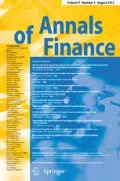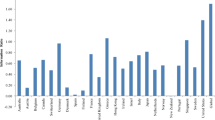Abstract
In this study, we investigate the skewness risk premium in the financial market under a general equilibrium setting. Extending the long-run risks (LRR) model proposed by Bansal and Yaron (J Financ 59:1481–1509, 2004) by introducing a stochastic jump intensity for jumps in the LRR factor and the variance of consumption growth rate, we provide an explicit representation for the skewness risk premium, as well as the volatility risk premium, in equilibrium. On the basis of the representation for the skewness risk premium, we propose a possible reason for the empirical facts of time-varying and negative risk-neutral skewness. Moreover, we also provide an equity risk premium representation of a linear factor pricing model with the variance and skewness risk premiums. The empirical results imply that the skewness risk premium, as well as the variance risk premium, has superior predictive power for future aggregate stock market index returns, which are consistent with the theoretical implication derived by our model. Compared with the variance risk premium, the results show that the skewness risk premium plays an independent and essential role for predicting the market index returns.










Similar content being viewed by others
Notes
The volatility (variance) risk premium is defined by the difference between two expected values of the volatility (variance) under the risk-neutral and physical probability measures, respectively.
The long-run risks model, which is a stylized self-contained general equilibrium model incorporating the effects of time-varying economic uncertainty, is pioneered by Bansal and Yaron (2004).
We can find that the correlation value between \(VIX_{t}^2\) and \(I{\textit{Skew}}_{t}\) in the same period is also nearly zero (see Table 2).
Because the datails of the four parameters, \(A_{x,m}\), \(A_{\sigma _m}\), \(A_{q,m}\), and \(A_{\lambda ,m}\), are insignificant and do not affect the discussion explored in the following at all. For simplicity, we express the parameters, \(A_{x,m}\), \(A_{\sigma _m}\), \(A_{q,m}\), and \(A_{\lambda ,m}\), as they are and do not show explicit representations of those parameters in this paper.
The empirical evidence of the negative correlation between the one-step-ahead market return, \(r_{m,t+1}\), and the one-step-ahead change of risk-neutral skewness, \(\bigtriangleup {\textit{Skew}}_{t+1}^{\mathbb {Q}} \equiv {\textit{Skew}}_{t+1}^{\mathbb {Q}} - {\textit{Skew}}_{t}^{\mathbb {Q}}\), also essentially shown by Neuberger (2012). He shows that the period when the S&P500 index volatility was very low by historic standards (from the year of 2003 to 2007) was also one of relatively low skewness, whereas skewness was actually rather high in the volatility spike of the year of 2008. Under the leverage effect of Black (1976), that evidence suggests the same essentially as that of the negative correlation between the one-step-ahead market return and the one-step-ahead change of risk-neutral skewness.
According to the description of the CBOE’s SKEW index, we have the proxy for the risk-neutral expected skewness, \(\mathbb {E}_t^{\mathbb {Q}} [{\textit{Skew}}_{t+1}^\mathbb {Q} (r_{m,t+2})]\), as \(\frac{1}{10} (100- {\textit{Skew}} \quad index)\).
In our model setting, the time-t skewness of the one-step-ahead market return, \(r_{m,t+1}\), can be expressed by (21). Thus, we can find that the first-order autocorrelation of the skewness under the physical measure \(\mathbb {P}\) (or the risk-neutral measure \(\mathbb {Q}\)) is determined by that of the jump intensity \(\lambda _t\). From (6), we can also find that the first-order autocorrelation of the jump intensity \(\lambda _t\) is \(\rho _\lambda \). Previous studies such as those by Chan and Maheu (2002) and Christoffersen et al. (2012) also model the dynamics of the jump intensity of financial asset returns as a first-order autoregressive model in a similar fashion, and they find that the \(\rho _\lambda \) parameters in the jump intensity models, which are estimated with historical data of stock indices, are more than 0.9 and show the strong persistence in the conditional jump intensity. So, on the basis of these previous studies, we could assume that the objective expected future skewness, \(\mathbb {E}_t^{\mathbb {P}} [{\textit{Skew}}_{t+1}^{\mathbb {P}} (r_{m,t+2})] \), will be close to the value of the current empirical skewness so that the same qualitative implications hold true for the skewness difference obtained by replacing \(\mathbb {E}_t^{\mathbb {P}} [Skew_{t+1}^{\mathbb {P}} (r_{m,t+2})] \) in the definition (22) with the current empirical skewness.
We thank a referee so much for suggesting the idea on this point.
In this case, under the assumption of i.i.d distribution for daily returns, \({\textit{Skew}}_t^D\) is the historical 22 days actual skewness of daily return data, which is devided by \(\sqrt{22}\).
References
Aït-Sahalia, Y., Lo, A.: Nonparametric estimation of state-price-densities implicit in financial asset prices. J Financ 53, 499–547 (1998)
Aït-Sahalia, Y., Wang, W., Yared, F.: Do option markets correctly price the probabilities of movement of the underlying asset? J Econ 102, 67–110 (2001)
Bakshi, G., Kapadia, N., Madan, D.: Stock return characteristics, skew laws, and the differential pricing of individual equity options. Rev Financ Stud 16, 101–143 (2003)
Bali, T., Hovakimian, A.: Volatility spread and expected stock returns. Manage Sci 55, 1797–1812 (2009)
Bansal, R., Yaron, A.: Risks for the long run: a potential resolution of asset-pricing puzzles. J Financ 59, 1481–1509 (2004)
Black, F.: Studies of stock market volatility changes. In: Proceedings of the American Statistical Association, Business and Economic Statistics Section, pp. 177–181, (1976)
Bollerslev, T., Sizova, N., Tauchen, G.: Volatility in equilibrium: asymmetries and dynamic dependencies. Rev Financ 16, 31–80 (2012)
Bollerslev, T., Tauchen, G., Zhou, H.: Expected stock returns and variance risk premia. Rev Financ Stud 22, 4463–4492 (2009)
Campbell, J., Shiller, R.J.: The dividend-price ratio and expectations of future dividends and discount factors. Rev Financ Stud 1, 195–227 (1988)
Chan, W., Maheu, J.M.: Conditional jump dynamics in stock market returns. J Bus Econ Stat 20, 377–389 (2002)
Chang, B., Christoffersen, Y.P., Jacobs, K.: Market skewness risk and the cross section of stock returns. J Financ Econ 107, 46–68 (2013)
Christoffersen, P., Jacobs, K., Ornthanalai, C.: Dynamic jump intensities and risk premiums: evidence from S&P500 returns and options. J Financ Econ 106, 447–472 (2012)
Cont, R., Tankov, P.: Financial Modeling with Jump Processes. London: Chapman & Hall (2004)
Demeterfi, K., Derman, E., Kamal, M., Zou, J.: A guide to volatility and variance swaps. J Deriv 6, 9–32 (1999)
Drechsler, I., Yaron, A.: What’s vol got to do with it? Rev Financ Stud 24, 1–45 (2011)
Driessen, J., Lin, T., Lu, X.: Why do option prices predict stock returns? Working paper (2012)
Epstein, L., Zin, S.: Substitution, risk aversion and the temporal behavior of consumption and asset returns: a theoretical framework. Econometrica 57, 937–969 (1989)
Eraker, B.: The volatility premium. Working paper, Department of Finance, University of Wisconsin (2008)
Lettau, M., Ludvigson, S.: Consumption, and expected stock returns. J Financ 56, 815–849 (2001)
Neuberger, A.: Realized skewness. Rev Financ Stud 26, 2174–2203 (2012)
Rehman, Z., Vilkov, G.: Risk-neutral skewness: return predictability and its sources. Working paper (2012)
Yan, S.: Jump risk, stock returns, and slope of implied volatility smile. J Financ Econ 99, 216–233 (2011)
Author information
Authors and Affiliations
Corresponding author
Additional information
For their helpful comments on this article, I especially wish to thank Hidetoshi Nakagawa, Kazuhiko Ohashi, Toshiki Honda, Nobuhiro Nakamura, Fumio Hayashi, Tatsuyoshi Okimoto, Ryozo Miura, and the participants at the Research Center for Mathematical Economics workshop in 2012 and the CSFI-CREST Seminar in 2013. I assume full responsibility for all errors.
Appendices
Appendix 1: Proof of Proposition 2
From (14),
where
and \(\Psi _{t+1,x}^{(2)} (0)\) and \(\Psi _{t+1,\sigma ^2}^{(2)} (0)\) are respectively the second derivative of the cgf (cumulant-generating function) for \(J_{x,t+1}\) and \(J_{\sigma ^2, t+1}\) evaluated at 0, that is,
Thus the expression of (28) is rearranged to the following representation,
where
Appendix 2: Proof of Proposition 3
From the definition of the variance risk premium (18) and the expressions of the conditional variance of the market return \(r_{m,t+2}\) at time \(t+1\) under each of the probability measures, we can derive the following expression,
where \(\Lambda _q \equiv (1-\theta ) \kappa _1 A_q\), \(\Lambda _\lambda \equiv (1-\theta ) \kappa _1 A_\lambda \) (see (13)), and
Substituting the following facts,
into (29) and considering (6) and (16), we can obtain the representation (20). \(\square \)
Appendix 3: The risk-free rate
The explicit expression of the risk-free rate can be obtained by substituting \(r_{f,t}\) into \(r_{j,t+1}\) in (3). We finally provide the following proposition on the risk-free rate \(r_{f,t}\).
Proposition 6
(The Risk-Free Rate) The risk free rate is expressed as follows with the state variables of \(\sigma _t^2\), \(q_t\), and \(\lambda _t\).
where
Rights and permissions
About this article
Cite this article
Sasaki, H. The skewness risk premium in equilibrium and stock return predictability. Ann Finance 12, 95–133 (2016). https://doi.org/10.1007/s10436-016-0275-7
Received:
Accepted:
Published:
Issue Date:
DOI: https://doi.org/10.1007/s10436-016-0275-7
Keywords
- Long-run risks model
- Epstein–Zin preferences
- Variance risk premium
- Skewness risk premium
- Stock return predictability
- Stochastic volatility
- Volatility of volatility
- Jump intensity




